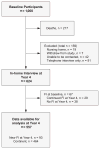Incidence and risk factors for fecal incontinence in black and white older adults: a population-based study
- PMID: 20533967
- PMCID: PMC3205963
- DOI: 10.1111/j.1532-5415.2010.02908.x
Incidence and risk factors for fecal incontinence in black and white older adults: a population-based study
Abstract
Objectives: To determine the incidence of fecal incontinence (FI) in community-dwelling older adults and identify risk factors associated with incident FI.
Design: Planned secondary analysis of a longitudinal, population-based cohort study.
Setting: Three rural and two urban Alabama counties (in-home assessments 2000-2005).
Participants: Stratified random sample of 1,000 Medicare beneficiaries: 25% African-American men, 25% white men, 25% African-American women, 25% white women, aged 65 and older. Eligible participants for this analysis were continent at baseline and community-dwelling 4 years later (n=557).
Measurements: FI was defined as any loss of control of bowels occurring during the previous year. Independent variables were sociodemographics, Charlson comorbidity counts, self-reported bowel symptoms (chronic diarrhea and constipation), depression, and body mass index (BMI). Multivariable logistic regression models were constructed using incident FI as the dependent variable.
Results: The incidence rate of FI at 4 years was 17% (95% confidence interval (CI)=13.7-20.1), with 6% developing FI at least monthly (95% CI=4.0-8.3). White women were more likely to have incident FI (22%) than African-American women (13%, P=.04); no racial differences were observed in men. Controlling for age, comorbidity count, and BMI, significant independent risk factors for incident FI in women were white race, depression, chronic diarrhea, and urinary incontinence (UI). UI was the only significant risk factor for incident FI in men.
Conclusion: The occurrence of new FI is common in men and women aged 65 and older, with a 17% incidence rate over 4 years. FI and UI may share common pathophysiologic mechanisms and need regular assessment in older adults.
Conflict of interest statement
Figures
Comment in
-
Fecal incontinence: possible role for drug-induced etiology.J Am Geriatr Soc. 2011 Jan;59(1):161-2; author reply 162-3. doi: 10.1111/j.1532-5415.2010.03211.x. J Am Geriatr Soc. 2011. PMID: 21226687 No abstract available.
Similar articles
-
Correlates of urinary, fecal, and dual incontinence in older African-American and white men and women.J Am Geriatr Soc. 2008 Feb;56(2):285-90. doi: 10.1111/j.1532-5415.2007.01509.x. Epub 2007 Dec 7. J Am Geriatr Soc. 2008. PMID: 18070007
-
Prevalence and correlates of fecal incontinence in community-dwelling older adults.J Am Geriatr Soc. 2005 Apr;53(4):629-35. doi: 10.1111/j.1532-5415.2005.53211.x. J Am Geriatr Soc. 2005. PMID: 15817009
-
Urinary, fecal, and dual incontinence in older U.S. Adults.J Am Geriatr Soc. 2015 May;63(5):947-53. doi: 10.1111/jgs.13385. Epub 2015 May 4. J Am Geriatr Soc. 2015. PMID: 25940401 Free PMC article.
-
Population based study of incidence and predictors of urinary incontinence in black and white older adults.J Urol. 2008 Apr;179(4):1449-53; discussion 1453-4. doi: 10.1016/j.juro.2007.11.069. Epub 2008 Mar 4. J Urol. 2008. PMID: 18295279 Free PMC article.
-
Prevention of urinary and fecal incontinence in adults.Evid Rep Technol Assess (Full Rep). 2007 Dec;(161):1-379. Evid Rep Technol Assess (Full Rep). 2007. PMID: 18457475 Free PMC article. Review.
Cited by
-
[Urinary incontinence in the elderly: what can and should be done?].Urologe A. 2013 Jun;52(6):805-12. doi: 10.1007/s00120-012-3061-9. Urologe A. 2013. PMID: 23404380 German.
-
Functional Anorectal Disorders.Gastroenterology. 2016 Mar 25:S0016-5085(16)00175-X 10.1053/j.gastro.2016.02.009. doi: 10.1053/j.gastro.2016.02.009. Online ahead of print. Gastroenterology. 2016. PMID: 27144630 Free PMC article.
-
Factors associated with quality of life among women with fecal incontinence.Int Urogynecol J. 2013 Mar;24(3):493-9. doi: 10.1007/s00192-012-1889-6. Epub 2012 Jul 18. Int Urogynecol J. 2013. PMID: 22806489
-
Risk factors for urinary, fecal, or dual incontinence in the Nurses' Health Study.Obstet Gynecol. 2013 Sep;122(3):539-45. doi: 10.1097/AOG.0b013e31829efbff. Obstet Gynecol. 2013. PMID: 23921863 Free PMC article.
-
Diet Modifications in Older Women With Fecal Incontinence: A Qualitative Study.Female Pelvic Med Reconstr Surg. 2020 Apr;26(4):239-243. doi: 10.1097/SPV.0000000000000702. Female Pelvic Med Reconstr Surg. 2020. PMID: 30747728 Free PMC article.
References
-
- Norton C, Whitehead WE, Bliss DZ, et al. Conservative and pharmacological management of faecal incontinence in adults. In: Abrams P, Cardozo L, Khoury S, et al., editors. Incontinence. 4. Paris, France: Health Publications, Ltd; 2009. pp. 1321–1386.
-
- Bharucha AE, Zinsmeister AR, Locke GR, et al. Prevalence and burden of fecal incontinence: A population-based study in women. Gastroenterology. 2005;129:42–49. - PubMed
-
- Macmillan AK, Merrie AEH, Marshall RJ, et al. The prevalence of fecal incontinence in community-dwelling adults: A systematic review of the literature. Dis Colon Rectum. 2004;47:1341–1349. - PubMed
-
- Nelson R, Norton N, Cautley E, et al. Community-based prevalence of anal incontinence. JAMA. 1995;274:559–561. - PubMed
Publication types
MeSH terms
Grants and funding
LinkOut - more resources
Full Text Sources
Medical


